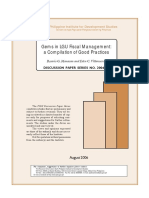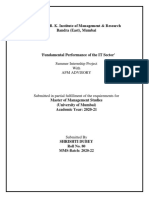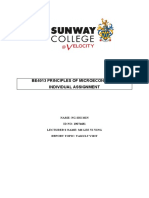OCDE
OCDE
Uploaded by
Brahiam Stiven Ortiz FernándezCopyright:
Available Formats
OCDE
OCDE
Uploaded by
Brahiam Stiven Ortiz FernándezCopyright
Available Formats
Share this document
Did you find this document useful?
Is this content inappropriate?
Copyright:
Available Formats
OCDE
OCDE
Uploaded by
Brahiam Stiven Ortiz FernándezCopyright:
Available Formats
│7
Summary and list of main policy options for Colombia
Colombia has the legal and the administrative framework in place to implement the country’s
decentralisation reforms. In addition, the Colombian decision-makers and civil servants are
able to benefit from the support and advice by the NDP, a major expert organisation for
decentralisation in Colombia. The current challenges of Colombian decentralisation are,
therefore, not the lack of legal bases or the shortage of guidance for implementing the desired
reforms. The focal areas for development comprise the capacity building of subnational
governments and enhanced implementation of existing policy tools. For the next several years,
Colombia should focus on making better use of the existing decentralisation instruments. In
addition, efforts to create new policy tools should be continued. In below is a summary of the
main policy alternatives discussed in this paper.
Making better use of existing instruments and strengthening the overall
decentralisation framework
Regional inequality in terms of GDP per capita is comparatively high in Colombia. This
together with large differences in service needs makes decentralisation challenging because the
subnational governments’ ability to provide public services is largely determined by the
funding available for them. According to the OECD reports on education and health services,
the financing and the outcomes of these services currently vary tremendously across Colombian
territories (OECD, 2015[7]; OECD, 2016[8]). Without measures that strengthen subnational
government fiscal and human resource capacities, including a mechanism that equalises the
differences in tax bases and service needs between subnational governments, the subnational
disparities in service outcomes are likely to stay at a high level.
The overall decentralisation framework in Colombia could be strengthened by improving the
subnational government fiscal and human resource capacities and by gradually increasing the
subnational government spending and revenue autonomy. Tax reform and reform of the
intergovernmental transfer system would support these policies. High quality information on
local fiscal capacity and service needs of local population will be needed to successfully
implement such reforms. Therefore, efforts to improve the quality of territorial indicators and
utilising ex ante and ex post analyses to study the impacts of the reforms should be continued
and deepened.
Strengthening administrative and service delivery capacities
Training more service professionals and employing them in subnational governments is
essential for building the local capacities. Colombia could consider creating special financial
incentives for medical and teaching staff to work in the most remote regions. In addition,
geographical targeting or selection of students and the location of education institutes that train
medical and teaching professionals could contribute to availability of high quality workforce
in regions. The methods of telemedicine and remote education could also be utilised (OECD,
2016[9]).
ASYMMETRIC DECENTRALISATION: POLICY IMPLICATIONS IN COLOMBIA © OECD 2019
8│
Colombia could consider developing a comprehensive assessment (both quantitatively and
qualitatively) of subnational public employees to get a clearer picture of the needs and gaps of
territorial entities (OECD, 2016[10]). The role of Departments for municipal capacity building
and technical support could be enhanced.
Building fiscal capacities and allowing for greater autonomy
The capacity of Colombian subnational governments to raise own-source revenues and to
enhance revenue autonomy should be strengthened. The alternative measures in this respect
include: (i) continuing the efforts to update and modernise the cadastral and land registries in
order to improve the performance of the municipal property tax; (ii) streamlining the portfolio
of taxes levied by departments and municipalities; (iii) reducing the number of earmarked
taxes; (iv) allowing instruments such as congestion charges or tolls; (v) promoting more
flexibility in terms of user tariffs and local fees and optimising income from properties (rents,
dividends) (OECD, 2016[10]).
Borrowing could be further used by subnational governments as a financing mechanism within
the limits of current fiscal rules. The fact that the level of subnational government debt has
decreased gives some room for using borrowing for productive investments. New options to
finance investments could also be explored in particular for large cities and metropolitan areas.
Subnational governments need however be further assisted to improve their use and
management of loans.
Reforming the transfer system
The reform of the transfer system (SGP) which has been discussed for several years should be
put in place. An in-depth examination of the transfer system’s (SGP) allocation criteria could
be conducted to find ways to include new equalisation mechanisms and to simplify the system.
The new criteria to be considered include indicators e.g. for territorial specificities (such as
differences in service needs, circumstantial factors and revenue bases). Allowing subnational
governments to re-use the unspent funds from one sector in another sector would make the
system more flexible and adaptive to local needs.
Matching grants could be used to finance investment at the subnational government level. At
the same time it should be ensured that differences in revenue bases do not affect too much the
ability to invest in necessary local infrastructure. Earmarked investment grants could be
established for specific projects and places, such as the City Fund (OECD, 2016[10]).
Intensifying the use of Contratos plans
While the Contratos Plans have supported the capacity building and overall infrastructure
development, there is still room for improvement. Special attention should be paid to the
implementation of Contratos Plans in order to further improve the effectiveness of the
investments (OECD 2016b). In general, the processes could be simplified, harmonised and
standardised. Horizontal co-ordination across the national government is also important,
especially to ensure that the key central government players involved in local projects listed in
the Contratos Plans work together. In addition, the reporting of Contratos Plans should be
improved. A more systematic and standardised reporting enables high quality impact
evaluations, which facilitates timely decision-making.
ASYMMETRIC DECENTRALISATION: POLICY IMPLICATIONS IN COLOMBIA © OECD 2019
│9
Promoting inter-municipal cooperation
Colombia could consider stepping up inter-municipal co-operation in the spirit of the LOOT
law, with special focus on regions where single municipalities are otherwise unlikely to be able
to reach adequate competence or sufficient economies of scale. Grant funding could be used to
incentivise cooperation, but in this case a priority should be given to projects where clear
benefits can be predicted from internalised externalities. Departments could also take a more
pro-active role to support critical projects with cross-jurisdictional cooperation, in particular
vis-à-vis rural municipalities (OECD, 2016[10]).
Further supporting horizontal cooperation across jurisdictions should be a priority especially at
the metropolitan level, notably for Bogotá, Cali or Cartagena, which are not yet structured as
metropolitan areas. Metropolitan areas should be given the status of “territorial entity”. Specific
tax regimes for inter-municipal groupings or metropolitan areas could be developed. Some pilot
experiments could be launched in this regard. Such measures should not however take
resources away from the municipalities, because this would be a great disincentive for
cooperation. Finally, specific contractual arrangements targeting specifically metropolitan
areas could be promoted. Departments could also take a more pro-active role to support critical
projects with cross-jurisdictional cooperation, in particular vis-à-vis rural municipalities
(OECD, 2016[10]).
Revising municipal classification
There is room for improvement in the classification of municipalities and departments. For
instance, using more variables to define the classification, or increasing the number of groups
used in classification, could be considered in order the get a better picture of the differences
between the subnational governments.
The indicators that are currently produced separately should be better aligned to create more
useful data for decision making. There are currently three municipal classifications/groupings:
the municipal classification, the performance rankings (MDM and the separate evaluations
carried out by line ministries) and the certifications. At present, each set of indicators have their
own use and it is unclear how these indicators are used jointly to target and coordinate policies.
A better co-ordination of the measuring and classifying the subnational governments could
contribute building more efficient and useful database for policy purposes.
Experimenting with targeted municipalities and departments
In order to facilitate experimenting Colombia could consider setting up a “free municipality”
experiment, by giving spending and revenue autonomy to a limited number of subnational
governments for a fixed period of time. These kinds of experiments have been practiced
especially in the Nordic countries (Denmark, Norway, Sweden and Finland) 1. Although the
results in the Nordic countries have not led to immediate reforms, the experiments have
nevertheless provided valuable information on the effects of reduced regulation at the
subnational government level. Colombia may also consider simplifying reporting requirements
for the municipalities with the lowest capacities to alleviate the administrative burden.
Colombia could consider setting a special program to strengthen the departments in a
differentiated and experimental manner. While capacity building should cover all subnational
1
Please see discussion on the Danish experiment in section 2.
ASYMMETRIC DECENTRALISATION: POLICY IMPLICATIONS IN COLOMBIA © OECD 2019
10 │
government levels, the departments are often responsible for the most demanding tasks and
their needs differ from those of municipalities.
Supporting the indigenous territories
Colombian government has recently made decisions to improve the autonomy of regions with
indigenous populations. The focus should now be on implementing the policies that support
the indigenous populations’ efforts for self-determination, and making sure that they have
adequate capacities to practice their extended rights. The policies concerning the indigenous
populations should be regularly evaluated and if problems occur, policies should be
strengthened. Indicators describing the indigenous regions should be developed to be able to
target supportive policies.
While the policies that support the indigenous regions to take more responsibilities and increase
their self-rule are a priority, it is important to simultaneously take into account the overall
territorial planning and public finances aspects. It is also essential to coordinate properly these
territories with the municipalities where they are located.
Monitoring performance
Colombia has recently made considerable efforts to create systematic guidance and online
databases on regional statistics to facilitate reforms. A good example of this is the recently
launched TerriData database, which comprises data on demographics, education, health, public
services, public finances and security for the departments and the municipalities. The first
results on Terridata are very promising. These efforts could still be continued and deepened,
using examples of best practices from other countries such as the Norwegian KOSTRA system.
While collecting new more accurate and useful information is a positive development, it should
also be ensured that the administrative burden at the local level is not increased too much.
Therefore, the older procedures or reporting requirements that have become obsolete or are
overlapping with new procedures ought to be eliminated.
Rethinking assignments
Colombia could consider preparing a nationwide plan on allocating spending and revenue
assignments. Better clarified roles, tasks and powers within Colombian multilevel governance
model would contribute to the efficiency and transparency of public service delivery. Reducing
duplication and overlapping assignments between subnational government levels results in
more efficient subnational tasks and eases co-ordination of the services. Reforming
assignments across government levels should be done periodically, for example every five
years.
Asymmetric decentralisation should support the overall decentralisation targets. Therefore also
the services selected for piloting the decentralisation should be in line with the nationwide plan
for decentralisation.
ASYMMETRIC DECENTRALISATION: POLICY IMPLICATIONS IN COLOMBIA © OECD 2019
│ 11
Summary of main policy alternatives suggested for implementing asymmetric
decentralisation in Colombia
• Improve the subnational government spending and revenue autonomy. Reforming
the transfer system (SGP) and the tax system (OECD, 2014[11]; OECD, 2017[2]) are
among key measures in order to provide better financial basis for subnational
governments and enabling subnational governments collect more own source
revenues.
• Strengthen the subnational government capacity by raising the number of high
quality professionals in municipalities and departments, in particular the teachers,
doctors and nurses, who have a crucial role in building the local capacity (OECD,
2016[8]; OECD, 2015[7]).
• Continue efforts to improve the skills and competences of civil servants and public
officials in subnational governments.
• Inter-municipal cooperation should be promoted in regions where single
municipalities are unlikely to be able to reach adequate competence or sufficient
economies of scale. Grant funding could be used to incentivise cooperation if
benefits can be predicted from internalised externalities.
• Consider setting up a “free municipality” experiment, by giving considerable
spending and revenue autonomy to a limited number of subnational governments
for a fixed period of time, in order to gain experience of enhanced subnational
autonomy.
• Specific tax regimes for inter-municipal groupings or metropolitan areas could be
promoted. Some pilot experiments could be launched in this regard. Such tax
regimes should not take resources away from the municipalities, however.
• Launching a special programme to strengthen the departments in a differentiated
and experimental manner should be considered, because the departments are often
responsible for the most demanding tasks and their needs differ from those of
municipalities.
• Alter the certification of subnational governments to ensure right incentives are in
place for efficient and effective service delivery. Use the new indicators, such as
MDM, to provide useful information in this respect. In addition, systematise the
evaluations currently performed by the line ministries to create service-specific
performance indicators.
• Adjust the method to classify subnational governments, for example by using more
characteristics and/or by increasing the number of groups to define the
classification. Use this information for enhanced targeting of differentiated policy
measures concerning subnational governments.
• Modify the criteria used to define the allocation of tasks for each level of
government to ensure effective coordination and to allow for important
externalities.
• Continue supporting the indigenous territories for self-determination by assisting
their capacity building. Develop indicators describing the indigenous regions to be
able to target supportive policies.
• Minimise the risk of increased inequity due to differentiated policies, by ensuring
that positive spillover effects result from the differentiated arrangements between
ASYMMETRIC DECENTRALISATION: POLICY IMPLICATIONS IN COLOMBIA © OECD 2019
12 │
subnational governments. For instance, encourage subnational governments to aid
their weaker neighbors, create frameworks for cooperation between subnational
governments and dissemination of best practices.
• Strengthen the implementation of Contratos Plans and enhance impact evaluation
of the projects to enable timely interventions if problems should occur. High quality
information also allows for rewarding good performance.
• Ensure that population censuses will be carried out on a regular basis, in order to
maintain and improve the quality of territorial indicators.
• Utilise ex ante analyses to better anticipate and predict the likely outcomes of
decentralisation reforms and differentiated assignments. Ex post analyses should
be designed and implemented with the support of expert agencies, universities and
research institutes.
ASYMMETRIC DECENTRALISATION: POLICY IMPLICATIONS IN COLOMBIA © OECD 2019
You might also like
- Model Answers - 116342Document6 pagesModel Answers - 116342Marius BuysNo ratings yet
- IA2 Worksheet-BONDS PAYABLE - 101010Document11 pagesIA2 Worksheet-BONDS PAYABLE - 101010aehy lznuscrfbjNo ratings yet
- LGU Fiscal Management-Best PracticesDocument39 pagesLGU Fiscal Management-Best PracticeshazelNo ratings yet
- Terms of ReferenceDocument8 pagesTerms of ReferenceABUAMMAR60100% (1)
- CE-15-10 - Transfer of Services To CPPDocument4 pagesCE-15-10 - Transfer of Services To CPPWest Dunbartonshire Labour GroupNo ratings yet
- Accrual Based Accountiung A PriorityDocument4 pagesAccrual Based Accountiung A PriorityVirender WangnooNo ratings yet
- The 2016 Subdivision Staging Policy Public Hearing DraftDocument72 pagesThe 2016 Subdivision Staging Policy Public Hearing DraftPlanning DocsNo ratings yet
- Kitchener 2013 Budget Preview Nov 5 2012Document52 pagesKitchener 2013 Budget Preview Nov 5 2012WR_RecordNo ratings yet
- 671 696 1 PBDocument44 pages671 696 1 PBJane GuiribaNo ratings yet
- Reflection 2 - Campos, Grace R.Document3 pagesReflection 2 - Campos, Grace R.Grace Revilla CamposNo ratings yet
- Speach CagDocument6 pagesSpeach Cag254186No ratings yet
- SatturDocument180 pagesSatturjoearunrajaNo ratings yet
- Lecture - Fiscal DecentralizationDocument17 pagesLecture - Fiscal DecentralizationSanam KhanNo ratings yet
- Public ManagementDocument14 pagesPublic ManagementSanjay AryalNo ratings yet
- 3409 14433 Iraq UNDG WB Housing Urbadn Executive SummaryDocument4 pages3409 14433 Iraq UNDG WB Housing Urbadn Executive SummaryChandan SrivastavaNo ratings yet
- 2014-10 Capitalising On The Boroughs FINALDocument20 pages2014-10 Capitalising On The Boroughs FINALscribdstorageNo ratings yet
- Ipsas Icpan FinalDocument23 pagesIpsas Icpan FinalAn TranNo ratings yet
- Rep HleDocument102 pagesRep HleblaiseinfoNo ratings yet
- Financial Management Model: For Local GovernmentsDocument11 pagesFinancial Management Model: For Local GovernmentsaisahNo ratings yet
- 10232012-Department Head Responses To Budget Study Committee Report 10-19-12Document23 pages10232012-Department Head Responses To Budget Study Committee Report 10-19-12keithmontpvtNo ratings yet
- What Is Bottom-Up Budgeting?Document10 pagesWhat Is Bottom-Up Budgeting?Mikki Eugenio88% (16)
- Final AssignmentDocument6 pagesFinal AssignmentZANGINA Nicholas NaaniNo ratings yet
- Housing UrbanDocument8 pagesHousing UrbanHazel May Agagas EstrellaNo ratings yet
- Assessing The Impact of The Municipal Financial Minimum Competency Programme On Expenditure ManagementDocument185 pagesAssessing The Impact of The Municipal Financial Minimum Competency Programme On Expenditure ManagementSERRAHNo ratings yet
- Good Governance in Local Government PDFDocument3 pagesGood Governance in Local Government PDFamirq4No ratings yet
- Local AutonomyDocument41 pagesLocal AutonomypuspitaNo ratings yet
- Katpadi Smart CityDocument164 pagesKatpadi Smart CityushaNo ratings yet
- LGC-Scope ReviewDocument34 pagesLGC-Scope ReviewKevin RiveraNo ratings yet
- Assessing The Level of Awareness of The Legal and Policy Frameworks On Cess Revenue Collection in Busia County GovernmentDocument16 pagesAssessing The Level of Awareness of The Legal and Policy Frameworks On Cess Revenue Collection in Busia County GovernmentInternational Journal of Innovative Science and Research TechnologyNo ratings yet
- The "Whole of Government Strategy Map": DR The Hon. Navinchandra Ramgoolam, GCSK, FRCP Prime MinisterDocument5 pagesThe "Whole of Government Strategy Map": DR The Hon. Navinchandra Ramgoolam, GCSK, FRCP Prime Ministerbooks.sriramNo ratings yet
- Government Statement On TPSDocument18 pagesGovernment Statement On TPSroland sawittoNo ratings yet
- Technical Assistance Consultant's ReportDocument7 pagesTechnical Assistance Consultant's ReportBernard Dela CruzNo ratings yet
- 30 April 2014Document31 pages30 April 2014Anonymous rStqCXlNo ratings yet
- Introduction Chapter OneDocument8 pagesIntroduction Chapter Oneannomjames1No ratings yet
- 10 enDocument12 pages10 enmarinel ramirezNo ratings yet
- AUS Ipsas ConfDocument11 pagesAUS Ipsas ConfAhsan Syed100% (1)
- Palacode PDFDocument170 pagesPalacode PDF63070No ratings yet
- Institutional Innovations For Urban Infrastructural DevelopmentDocument22 pagesInstitutional Innovations For Urban Infrastructural DevelopmentGhotna ChatterjeeNo ratings yet
- How To Address Regional and Sector-Specific Regulatory Issues? Case Study On MozambiqueDocument21 pagesHow To Address Regional and Sector-Specific Regulatory Issues? Case Study On MozambiqueaswardiNo ratings yet
- Areas of Concern in IndiaDocument17 pagesAreas of Concern in IndiaElle Gio CasibangNo ratings yet
- Tenkasi City PlanDocument191 pagesTenkasi City PlanChenthur GardenNo ratings yet
- Government Budgeting & Expenditures Issues & ProblemsDocument15 pagesGovernment Budgeting & Expenditures Issues & ProblemsHadidja Abas RecodoNo ratings yet
- Foreword: M L Selepeng Permanent Secretary To The PresidentDocument11 pagesForeword: M L Selepeng Permanent Secretary To The PresidentKing Ken MolefaneNo ratings yet
- DRS Business Case - Barnet CouncilDocument161 pagesDRS Business Case - Barnet CouncilMisterMustardNo ratings yet
- Philippines Decentralisation RRLDocument13 pagesPhilippines Decentralisation RRLDaniel Paulo MangampatNo ratings yet
- Fiscal Impact AssessmentDocument41 pagesFiscal Impact AssessmentPranalNo ratings yet
- Challenges To Budget Implementation in Public Institutions at The Local Level of GhanaDocument9 pagesChallenges To Budget Implementation in Public Institutions at The Local Level of GhanaInternational Journal of Innovative Science and Research TechnologyNo ratings yet
- Review PDFDocument24 pagesReview PDFBenny fernandesNo ratings yet
- Political Economy Analysis of Kompak Policy and Advocacy ApproachesDocument44 pagesPolitical Economy Analysis of Kompak Policy and Advocacy ApproachesArif DarmawanNo ratings yet
- Policy Paper v2Document35 pagesPolicy Paper v2Makoto ShinjuNo ratings yet
- Zero Based BudgetingDocument15 pagesZero Based BudgetingITUMELENG POHOTONANo ratings yet
- Influence of System Operational Efficiency On Revenue Collection in Kenya - A Case of Malaba Border Customs OfficeDocument34 pagesInfluence of System Operational Efficiency On Revenue Collection in Kenya - A Case of Malaba Border Customs Officekelvin giathiNo ratings yet
- TISAP Making The Move, Choices and Consequences Full ReportDocument68 pagesTISAP Making The Move, Choices and Consequences Full ReportGillian GraceNo ratings yet
- Gingee PDFDocument163 pagesGingee PDFvenkat_060No ratings yet
- The Stakeholders in Urban GovernanceDocument30 pagesThe Stakeholders in Urban GovernanceAlex Sanchez0% (1)
- HRM Strategic Priorities - 2008/2009: Part A-Hrm Community VisionDocument10 pagesHRM Strategic Priorities - 2008/2009: Part A-Hrm Community VisionAkram RahiNo ratings yet
- Priorities PDFDocument10 pagesPriorities PDFAkram RahiNo ratings yet
- Fiscal Decentralization Reform in Cambodia: Progress over the Past Decade and OpportunitiesFrom EverandFiscal Decentralization Reform in Cambodia: Progress over the Past Decade and OpportunitiesNo ratings yet
- Chapter 9 - Municipal Consumer Debt in South AfricaDocument15 pagesChapter 9 - Municipal Consumer Debt in South AfricathanhvantvNo ratings yet
- Procurement and Supply Chain Management: Emerging Concepts, Strategies and ChallengesFrom EverandProcurement and Supply Chain Management: Emerging Concepts, Strategies and ChallengesRating: 4 out of 5 stars4/5 (1)
- Strengthening Fiscal Decentralization in Nepal’s Transition to FederalismFrom EverandStrengthening Fiscal Decentralization in Nepal’s Transition to FederalismNo ratings yet
- CandlesDocument6 pagesCandlesCrypto BitcoinNo ratings yet
- Quiz 1 (16 Dec 2022, Questions)Document2 pagesQuiz 1 (16 Dec 2022, Questions)Teo ShengNo ratings yet
- Competent Synergies ProfileDocument34 pagesCompetent Synergies Profilerohit saxenaNo ratings yet
- Synopsis of The Report: Title - Comparative Study of Car Loan With Refrence To Sbi & PNBDocument1 pageSynopsis of The Report: Title - Comparative Study of Car Loan With Refrence To Sbi & PNBHarsimar NarulaNo ratings yet
- Token MetricsDocument2 pagesToken MetricspradiptajvrNo ratings yet
- BudgetingDocument2 pagesBudgetingRyoma EchizenNo ratings yet
- UTR Registration BY POSTDocument5 pagesUTR Registration BY POSTMadalina Maria MNo ratings yet
- SOL. MAN. CHAPTER 5 CORPORATE LIQUIDATION REORGANIZATION 2020 EDITION - Docx 070455Document24 pagesSOL. MAN. CHAPTER 5 CORPORATE LIQUIDATION REORGANIZATION 2020 EDITION - Docx 070455ChristianNo ratings yet
- Priya Jaswal: Career ObjectiveDocument2 pagesPriya Jaswal: Career ObjectiveAshwani JaswalNo ratings yet
- Course - Legal Aspects of Business: Individual Project WorkDocument5 pagesCourse - Legal Aspects of Business: Individual Project WorkAaditya ByadwalNo ratings yet
- Taxation UK ACCA F6Document9 pagesTaxation UK ACCA F6Ankit DubeyNo ratings yet
- Registration and Transfer of Certificated Securities. - (1) A Certificate Evidencing Any Certificated Securities of A CompanyDocument7 pagesRegistration and Transfer of Certificated Securities. - (1) A Certificate Evidencing Any Certificated Securities of A CompanyCraig CremenNo ratings yet
- Topic 6 - Money Makes The World Go RoundDocument2 pagesTopic 6 - Money Makes The World Go RoundMaster ZoliNo ratings yet
- Educational Material - ICAI Valuation Standard 103 - Valuation Approaches and MethodsDocument172 pagesEducational Material - ICAI Valuation Standard 103 - Valuation Approaches and MethodsJishnuNichinNo ratings yet
- 211010-015-051233 - 16413193 GST BillDocument1 page211010-015-051233 - 16413193 GST BillPratik DiyoraNo ratings yet
- Blue Design Resume-WPS OfficeDocument1 pageBlue Design Resume-WPS OfficeJerry PasaribuNo ratings yet
- Republic-Act-9520 Aka Philippine Coop CodeDocument30 pagesRepublic-Act-9520 Aka Philippine Coop Codethe 13th fridayNo ratings yet
- Walgreens Strategic Business PlanDocument8 pagesWalgreens Strategic Business Planhf6hf6hw100% (1)
- Elleine Maling - E-TIVITY 1 IA2Document8 pagesElleine Maling - E-TIVITY 1 IA2Rose MalingNo ratings yet
- Sip Report (Final)Document51 pagesSip Report (Final)anzalan arshiNo ratings yet
- On December AcctDocument4 pagesOn December AcctMelody BautistaNo ratings yet
- FINAL 99.1 1st SamplexDocument6 pagesFINAL 99.1 1st SamplexMelissa FelicianoNo ratings yet
- Be4013 Principles of Microeconomics Individual AssignmentDocument3 pagesBe4013 Principles of Microeconomics Individual Assignmentng shiminNo ratings yet
- Date Sheet For Term-End Examination, June, 2018: 10th May, 2018Document7 pagesDate Sheet For Term-End Examination, June, 2018: 10th May, 2018Mir Haroon KaiserNo ratings yet
- Sap MRP ProcedureDocument73 pagesSap MRP ProcedureJosé Robles100% (1)
- Mrunal's Economy Win20CSP Updates Pillar#2B: ATMA NIRBHAR Page 27Document35 pagesMrunal's Economy Win20CSP Updates Pillar#2B: ATMA NIRBHAR Page 27Ali SmartNo ratings yet
- Purchasing Officer Job DescriptionDocument2 pagesPurchasing Officer Job Descriptioncjarellano657No ratings yet
- EsP 8 Q1 LASDocument63 pagesEsP 8 Q1 LASBobby Cuares100% (1)
- Al Ikhsan Issue and ReccomendationsDocument5 pagesAl Ikhsan Issue and ReccomendationsN AzadNo ratings yet

























































































